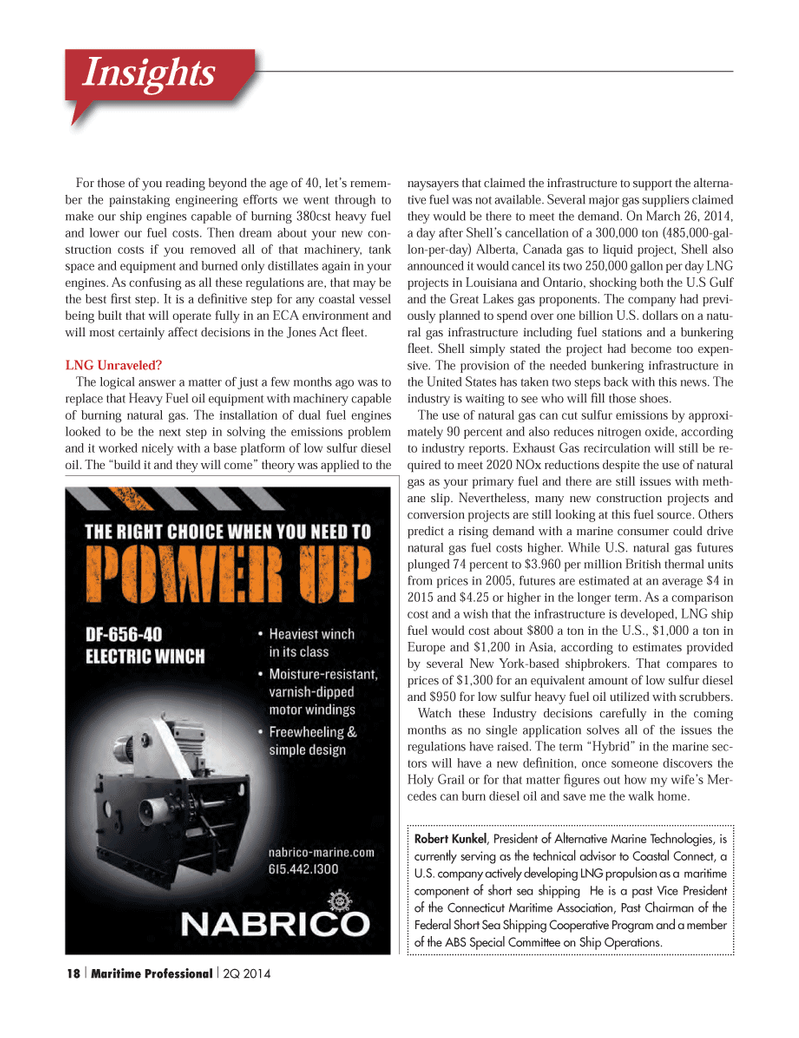
Page 18: of Maritime Logistics Professional Magazine (Q2 2014)
Maritime Risk & Shipping Finance
Read this page in Pdf, Flash or Html5 edition of Q2 2014 Maritime Logistics Professional Magazine
For those of you reading beyond the age of 40, let’s remem- ber the painstaking engineering efforts we went through to make our ship engines capable of burning 380cst heavy fuel and lower our fuel costs. Then dream about your new con- struction costs if you removed all of that machinery, tank space and equipment and burned only distillates again in your engines. As confusing as all these regulations are, that may be the best fi rst step. It is a defi nitive step for any coastal vessel being built that will operate fully in an ECA environment and will most certainly affect decisions in the Jones Act fl eet.
LNG Unraveled?
The logical answer a matter of just a few months ago was to replace that Heavy Fuel oil equipment with machinery capable of burning natural gas. The installation of dual fuel engines looked to be the next step in solving the emissions problem and it worked nicely with a base platform of low sulfur diesel oil. The “build it and they will come” theory was applied to the naysayers that claimed the infrastructure to support the alterna- tive fuel was not available. Several major gas suppliers claimed they would be there to meet the demand. On March 26, 2014, a day after Shell’s cancellation of a 300,000 ton (485,000-gal- lon-per-day) Alberta, Canada gas to liquid project, Shell also announced it would cancel its two 250,000 gallon per day LNG projects in Louisiana and Ontario, shocking both the U.S Gulf and the Great Lakes gas proponents. The company had previ- ously planned to spend over one billion U.S. dollars on a natu- ral gas infrastructure including fuel stations and a bunkering fl eet. Shell simply stated the project had become too expen- sive. The provision of the needed bunkering infrastructure in the United States has taken two steps back with this news. The industry is waiting to see who will fi ll those shoes.
The use of natural gas can cut sulfur emissions by approxi- mately 90 percent and also reduces nitrogen oxide, according to industry reports. Exhaust Gas recirculation will still be re- quired to meet 2020 NOx reductions despite the use of natural gas as your primary fuel and there are still issues with meth- ane slip. Nevertheless, many new construction projects and conversion projects are still looking at this fuel source. Others predict a rising demand with a marine consumer could drive natural gas fuel costs higher. While U.S. natural gas futures plunged 74 percent to $3.960 per million British thermal units from prices in 2005, futures are estimated at an average $4 in 2015 and $4.25 or higher in the longer term. As a comparison cost and a wish that the infrastructure is developed, LNG ship fuel would cost about $800 a ton in the U.S., $1,000 a ton in
Europe and $1,200 in Asia, according to estimates provided by several New York-based shipbrokers. That compares to prices of $1,300 for an equivalent amount of low sulfur diesel and $950 for low sulfur heavy fuel oil utilized with scrubbers.
Watch these Industry decisions carefully in the coming months as no single application solves all of the issues the regulations have raised. The term “Hybrid” in the marine sec- tors will have a new defi nition, once someone discovers the
Holy Grail or for that matter fi gures out how my wife’s Mer- cedes can burn diesel oil and save me the walk home.
Insights
Robert Kunkel, President of Alternative Marine Technologies, is currently serving as the technical advisor to Coastal Connect, a
U.S. company actively developing LNG propulsion as a maritime component of short sea shipping He is a past Vice President of the Connecticut Maritime Association, Past Chairman of the
Federal Short Sea Shipping Cooperative Program and a member of the ABS Special Committee on Ship Operations. 18 | Maritime Professional | 2Q 2014 18-33 Q2 MP2014.indd 18 5/16/2014 2:50:06 PM

 17
17

 19
19
